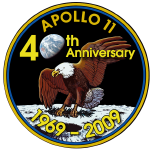 |
Forty years ago, the race for the Moon was nearing its climax.
The Mercury and Gemini Projects had paved the way for even more ambitious missions. The years of planning and investigating possible lunar landing sites were over – the hard work of tracking the Ranger, Surveyor and Lunar Orbiter spacecraft by the Deep Space Network had paid off. Now, at breakneck speed, the manned Apollo missions began. Apollo 7 was the first real test for Honeysuckle Creek, in October 1968.
Following that successful Earth-orbit checkout of the Command and Service Modules, the groundbreaking Apollo 8 flew to the Moon at Christmas 1968. With so many ‘firsts’ – the first men to ride a Saturn V; the first to fly higher than 850 miles; the first to leave the Earth’s gravitational influence; the first men to be cut off from view of the Earth; the first men to enter lunar orbit and see the lunar farside; the first to leave lunar orbit and to enter the Earth’s atmosphere at lunar return velocities – in many ways, Apollo 8 won the race to the Moon. It also tested, for the first time, the full capabilites of the Manned Space Flight Network operating at lunar distances.
However, as 1969 began, the pace picked up even further, with Apollo 9 testing the Lunar Module in Earth orbit in March. In May, Apollo 10 made mankind’s second visit to lunar orbit, with Lunar Module, Snoopy, dropping to just ten miles above the surface.
The world stopped, in late July 1969, as Apollo 11 made the first lunar landing – and hundreds of millions of people watched Neil Armstrong step onto the surface. The live picture they watched came from Honeysuckle Creek for the first nine minutes of the broadcast.
The Apollo missions continued – Apollo 12 flew to the Moon in November. Apollo 13 brought triumph from near-tragedy in April 1970. After Apollo 14, in February 1971, the final three lunar missions (dubbed the J Missions) – Apollo 15 (July 1971), Apollo 16 (April 1972) and Apollo 17 (December 1972) – were technically much more complex and required even greater levels of communications support from the Manned Space Flight Network.
As each 40th anniversary rolls by, we plan to highlight Honeysuckle’s role in each of these pioneering missions – cumulatively the greatest technical achievement of the twentieth century.
Mike Dinn: That period from Apollo 7 through Apollo 11 was probably one of the busiest of my career, and I suspect the rest of the HSK crew. But we all seemed to cope, with no dramas. Youth, confidence (through training and simulation), and confidence that everybody else involved in the missions knew what they were doing. One memory I had was that we had documentation for the next mission arriving before the previous one was flown! |
Bryan Sullivan on Apollo 7: I can still remember the excitement at HSK as we were about hear US voices on the downlink for the first time. The first local SIMS with a GSFC/NASA 421 team was a real hoot but never the less a harrowing experience. It was the first time I got the feeling of the responsibility for the 642B computers and understood the significance of ‘what if it is my piece of equipment that causes the mission to fail or, worse still, the loss of the astronauts?’. |